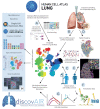The discovAIR project: a roadmap towards the Human Lung Cell Atlas
- PMID: 35086829
- PMCID: PMC9386332
- DOI: 10.1183/13993003.02057-2021
The discovAIR project: a roadmap towards the Human Lung Cell Atlas
Abstract
The Human Cell Atlas (HCA) consortium aims to establish an atlas of all organs in the healthy human body at single-cell resolution to increase our understanding of basic biological processes that govern development, physiology and anatomy, and to accelerate diagnosis and treatment of disease. The Lung Biological Network of the HCA aims to generate the Human Lung Cell Atlas as a reference for the cellular repertoire, molecular cell states and phenotypes, and cell-cell interactions that characterise normal lung homeostasis in healthy lung tissue. Such a reference atlas of the healthy human lung will facilitate mapping the changes in the cellular landscape in disease. The discovAIR project is one of six pilot actions for the HCA funded by the European Commission in the context of the H2020 framework programme. discovAIR aims to establish the first draft of an integrated Human Lung Cell Atlas, combining single-cell transcriptional and epigenetic profiling with spatially resolving techniques on matched tissue samples, as well as including a number of chronic and infectious diseases of the lung. The integrated Human Lung Cell Atlas will be available as a resource for the wider respiratory community, including basic and translational scientists, clinical medicine, and the private sector, as well as for patients with lung disease and the interested lay public. We anticipate that the Human Lung Cell Atlas will be the founding stone for a more detailed understanding of the pathogenesis of lung diseases, guiding the design of novel diagnostics and preventive or curative interventions.
Copyright ©The authors 2022.
Conflict of interest statement
Conflict of interest: F.J. Theis reports personal fees and nonfinancial support from Cellarity and Dermagnostix, during the conduct of the study. J. Schniering was supported by an ERS/EU RESPIRE4 Marie Skłlodowska-Curie Postdoctoral Fellowship. J. Lundeberg reports personal fees from 10x Genomics, outside the submitted work. P. Powell and J. Denning are employees of the European Lung Foundation. W. Timens reports personal fees from Merck Sharp Dohme and Bristol-Myers-Squibb, outside the submitted work. M. Nilsson reports personal fees from 10x Genomics, outside the submitted work. G.H. Koppelman reports grants from the Netherlands Lung Foundation, GlaxoSmithKline, Vertex, TEVA, UBBO EMMIUS Foundation and European Union (H2020 grant), outside the submitted work, and has participated in advisory board meetings to GlaxoSmithKline and PURE-IMS, outside the submitted work. M. van den Berge reports research grants paid to UMCG from GlaxoSmithKline, Genentech, Roche and Novartis, outside the submitted work. M.C. Nawijn reports grants from the European Commission, Chan Zuckerberg Initiative and Netherlands Lung Foundation, during the conduct of the study; grants from GlaxoSmithKline, outside the submitted work. All other authors do not have a conflict of interest.
Figures

References
-
- World Health Organization . Fact sheets. 2021. www.who.int/news-room/fact-sheets Date last accessed: 19 July 2021.
Publication types
MeSH terms
Grants and funding
LinkOut - more resources
Full Text Sources
Medical
